HP EX920 SSD Review: Affordable And Fast Mainstream NVMe
Why you can trust Tom's Hardware
512GB Performance Testing
Comparison Products
We crammed in as many products as we could to give us a broad comparison. We start with the previous-generation SMI SM2260 NVMe controller on the low-cost Intel 600p. We also include its successor and virtual hardware twin, the Intel 760p. We couldn't include it on the previous page because Intel hasn't shipped the 1TB model to retail.
Old favorites also come back to make an appearance. The 480GB MyDigitalSSD BPX was all the rage last year, but MLC flash production has ended. The Toshiba RD400 also uses MLC flash, but it is still the company's NVMe flagship. The Plextor M9Pe uses more modern 64-layer 3D TLC flash. We're testing the HHHL add-in card configuration that comes with a beefy heatsink.
The Samsung 960 Pro makes an appearance, as does the PM981, which is the OEM 64-layer TLC drive with the new Samsung Phoenix controller. The WD's new Black 3D NVMe SSD recently surpassed the Black PCIe, but we have yet to test the new 500GB model. We used the older model instead.
Sequential Read Performance
To read about our storage tests in-depth, please check out How We Test HDDs And SSDs. We cover four-corner testing on page six of our How We Test guide.


The HP EX920 is the only drive that matches the 512GB Samsung 960 Pro in this test. The two drives tower above the others. The 960 Pro still has a strong advantage at QD1, but the EX920 isn't too far behind. The two drives are nearly neck and neck at QD2 with roughly 3,200 MB/s of sequential throughput.
Sequential Write Performance


Like we saw on the previous page, the EX920 can't write sequential data as fast as the 960 Pro. Unlike the 1TB model, the 512GB EX920 is faster than many of its competitors in this workload. This is exactly why we like to test as many capacities as possible. Even though these products share the same name, the architecture can favor one capacity point over another. It's important to test the drives at different capacities if you want to use the information to make a purchasing decision.
Sequential Write Cache
Silicon Motion improved its SLC buffer algorithm after it encountered problems with the SM2260. After the SLC buffer is full, the SM2260 folds the data to the TLC from the SLC buffer rather than open up a direct channel to the TLC flash. The new system doesn't force all of the data through the SLC buffer. That increases performance during extended uses, like when you write a large block of data, like a Blu-Ray movie. Or in this case, a directory of them.
Get Tom's Hardware's best news and in-depth reviews, straight to your inbox.
The EX920's SLC buffer is large enough to write two Blu-Ray ISO disks before any data moves to the TLC. The system is much more aggressive than most other TLC-based SSDs on the market. The buffer is also dynamic, so it shrinks based on how much data you have stored on the drive.
Random Read Performance



The 512GB EX920's random read performance is very impressive. We've brought up the new HP drives in other reviews, and this is a big reason why. For many users, random read performance is the most important metric. Random read latency has a direct link to system snappiness when you load applications or move between windows.
Random Write Performance
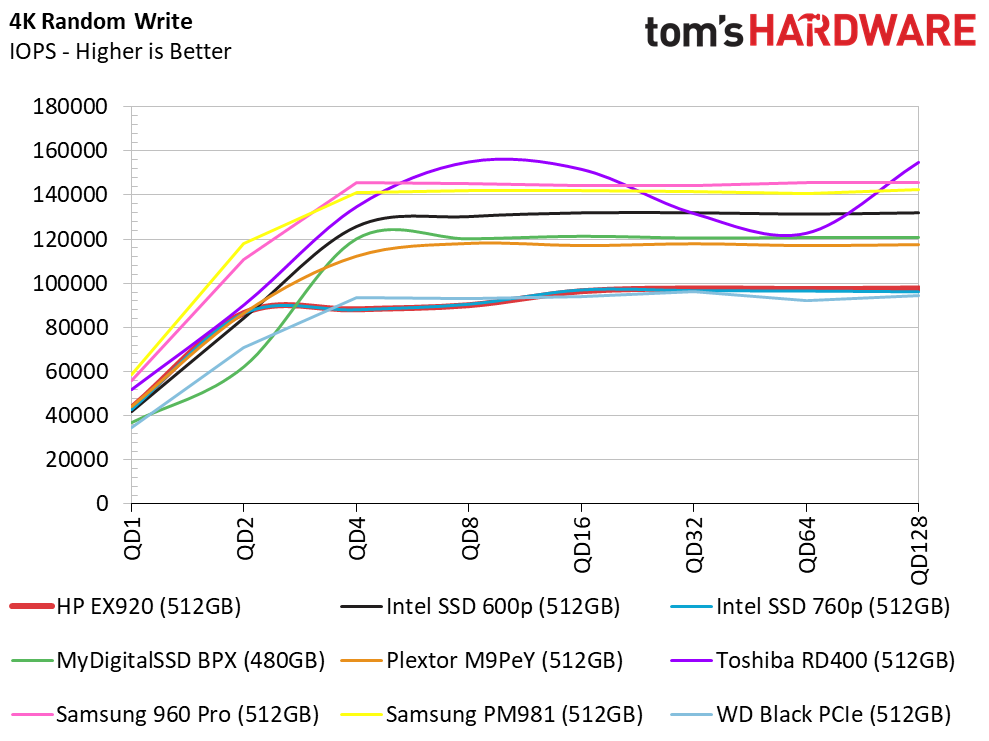


The EX920's random write performance gets lost on the line chart with the Intel SSD 760p. Both drives use the same controller, but there are slight differences between Intel and Micron 64-layer flash, even though it is the same design. This is the EX920's weak point during typical desktop workloads, but luckily all of the drives are fast enough to satisfy the operating system's write requests quickly.
70% Mixed Sequential Workload
We describe our mixed workload testing in detail here and describe our steady state tests here.
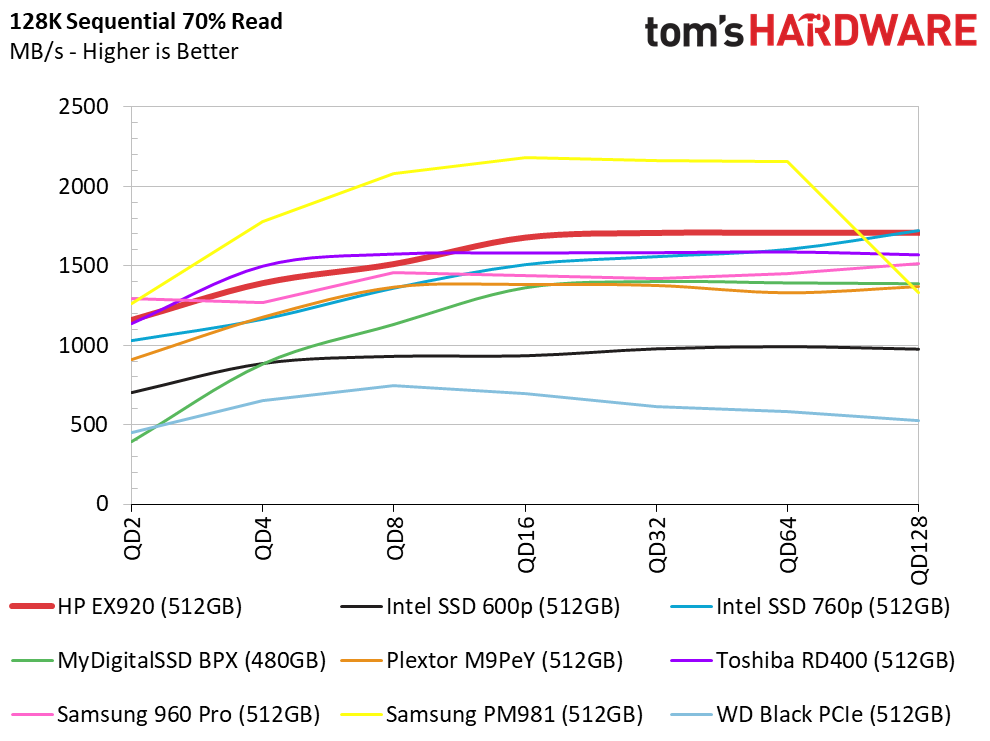

Samsung made targeted improvements to mixed workloads with the new Phoenix controller, and the industry will take notice. Mixed workloads have already been in the hot seat, so to speak, for the last few years after we began analyzing this metric on consumer SSDs. The HP EX920 performs very well. The EX920 is faster in this test than the Intel 760p, which has the same controller.
70% Mixed Random Workload

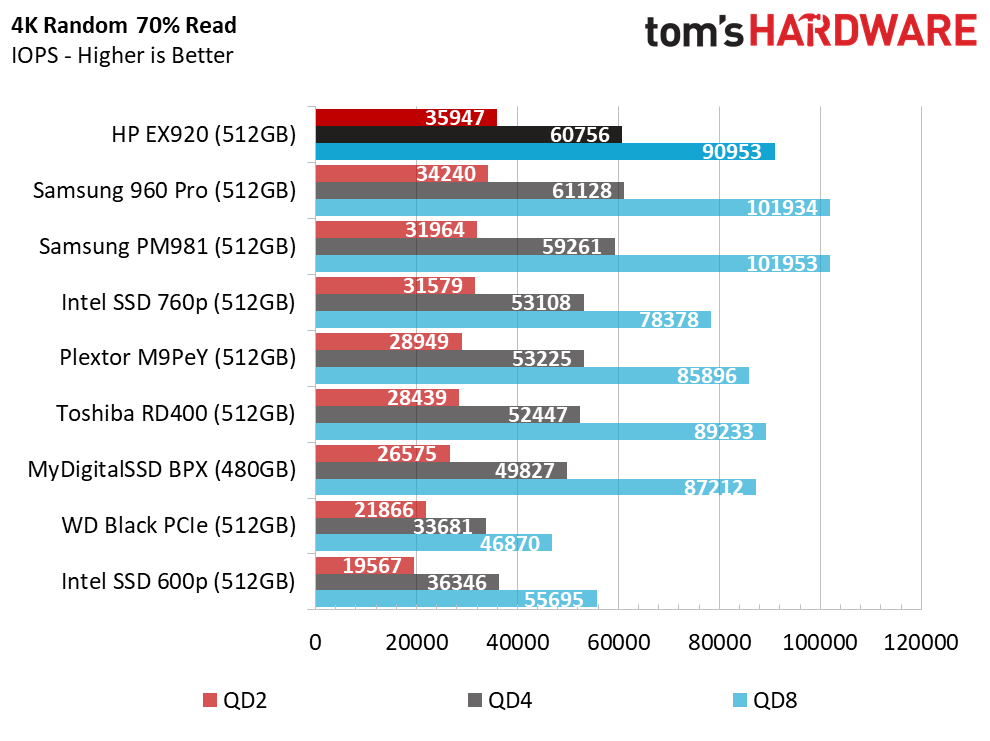
The EX920 also performs very well with mixed random data. The drive leads others in this capacity at QD2, and performance remains strong as we intensify the workload. Our main focus remains in the QD2 to QD4 range because that is applicable normal desktop applications. The 512GB EX920 is one of the better products we've tested for general computing.
Sequential Steady-State



HP didn’t design the EX920 for workstations with heavy workloads, but we still like to run this test to find crossover products. The drive performs well under these conditions, but the EX920 is only rated for 200 terabytes of endurance, which would run out quickly.
Random Steady-State
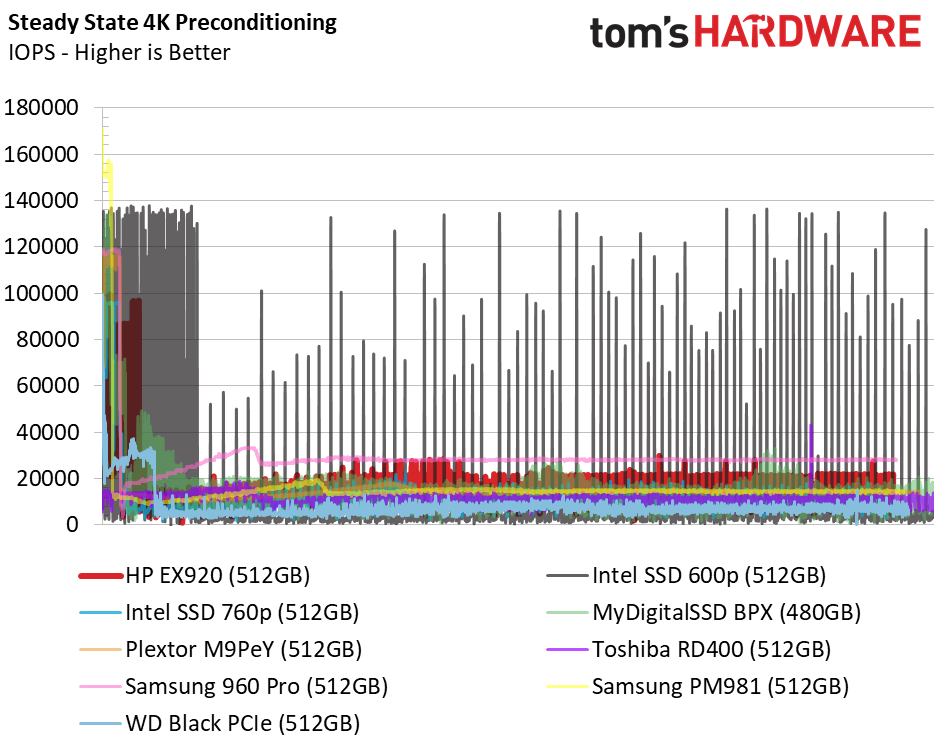
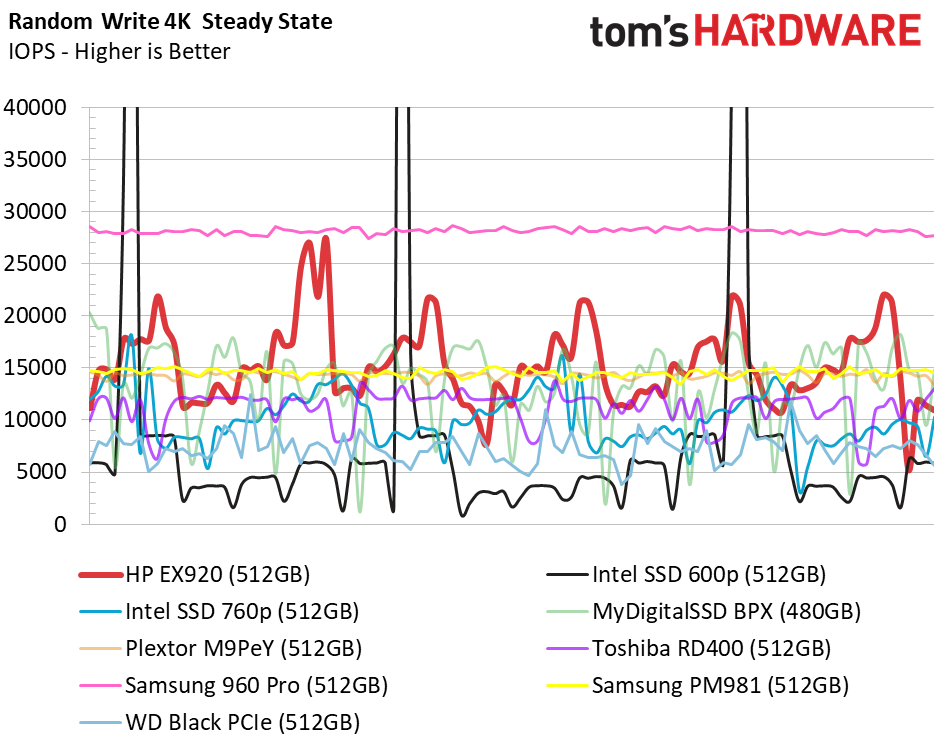
The EX920's buffer favors burst performance over long random write sessions. The cache would still give you very good performance in RAID 0, even though it's not as consistent. There is enough buffer to smooth out random write performance during typical desktop workloads.
PCMark 8 Real-World Software Performance
For details on our real-world software performance testing, please click here.







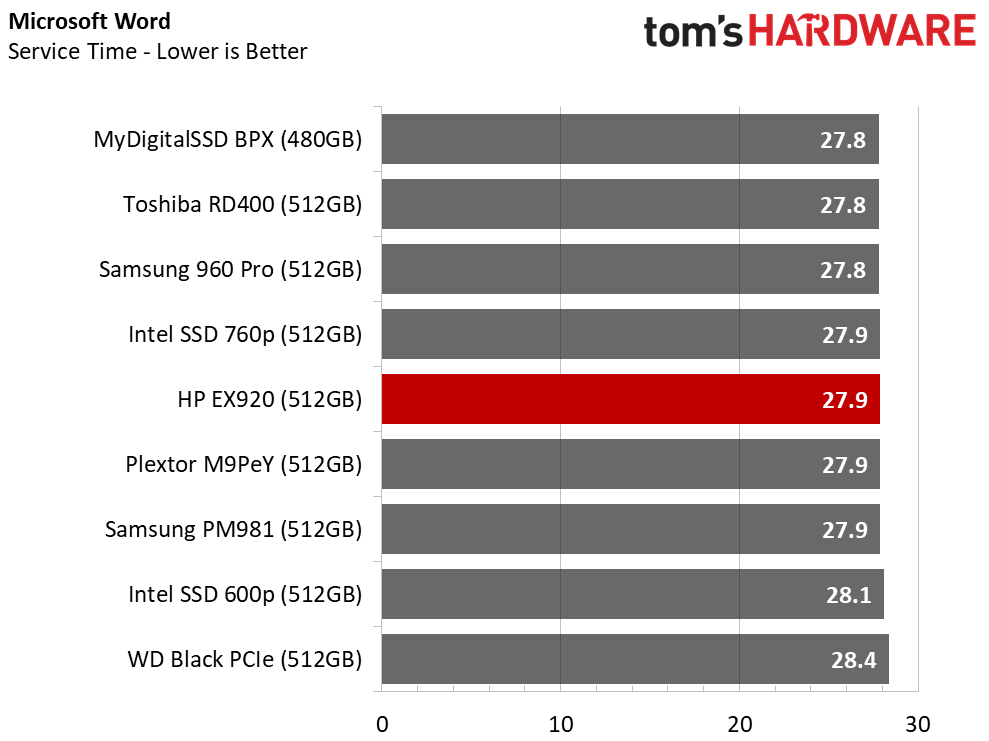


The 512GB EX920 is less impressive in this test than the 1TB model. The drive is still very fast, but it doesn't dominate the other TLC products like the 1TB EX920 did.
Application Storage Bandwidth
The EX920 performs better than the more expensive Intel SSD 760p, but it trails many of the other products. The faster products in this test all come with bigger price tags. The Samsung 960 EVO scores an impressive 499 MB/s, but the EX920 outperforms it, too.
PCMark 8 Advanced Workload Performance
To learn how we test advanced workload performance, please click here.



On the previous page, we discussed the EX920'a low performance after an extended test cycle. This is likely a symptom of the background garbage collection working to clean up all of the extra space rather than pausing when foreground activity resumes.
Total Service Time



The service time test shows us the latency spike during the recovery phase, which backs up our assumption. We reached out to SMI to learn more, but it hasn't responded yet.
Disk Busy Time
Silicon Motion's NVMe controllers have a small history of issues with high latency, as you can see here with the Intel 600P during heavy workloads and the EX920 during the recovery phases. The Intel 760p doesn't suffer from the same issue, so we are sure HP could fix the issue with a firmware update.
BAPCo SYSmark 2014 SE Responsiveness Test


The 1TB HP EX920 scores 1046 points on the responsiveness scale and the 512GB model weighs in at 1041. The 512GB EX920's responsiveness score matches the Samsung 950 Pro, and is much better than the Samsung 960 EVO (1033).
BAPCo MobileMark 2012.5 Notebook Battery Life
To learn how we test advanced workload performance, please click here.


The HP EX920 delivers just over five hours of notebook battery life with our Lenovo Y700-17 gaming notebook. That's an acceptable result, but there are better options that provide longer notebook battery life.
MORE: Best SSDs
MORE: How We Test HDDs And SSDs
MORE: All SSD Content
Current page: 512GB Performance Testing
Prev Page 1TB Performance Testing Next Page 256GB Performance Testing
Chris Ramseyer was a senior contributing editor for Tom's Hardware. He tested and reviewed consumer storage.
-
AgentLozen They're on each capacity's respective page.Reply
For example, look at the top of this page: https://www.tomshardware.com/reviews/hp-ex920-ssd,5527-2.html -
2Be_or_Not2Be Does the retail package would come with utilities (like Samsung's Magician SSD software) or disk-cloning software?Reply -
2Be_or_Not2Be Also, the 1TB EX920 is currently on sale at Newegg for $299 USD ($50-70 less than Amazon) through 5/24.Reply -
Evolution2001 So this poses an interesting and quite timely question.Reply
I'm about to upgrade a new laptop from it's OEM 256GB to a 480/512GB NVMe PCIe drive.
Battery life matters, but it's not the only consideration.
The MyDigitalSSD BPX 480GB is currently listing for $180. But has pretty horrible impact on battery life. Almost a full 90 minutes compared to the top performers. 90 minutes is a lot when AC power is not an option.
The HP, receiving an Editors Choice, seems on par performance-wise, AND ups the ante on battery life. Selling for $200.
Overall, this would appear to dethrone the BPX 480 for "best buy". Equal performance, more storage, and better battery life.
But now Samsung throws this wrench into the mix.
Samsung.com and other reputable vendors have the Samsung 970 PRO 512GB for $250. For an additional $50 over the HP EX920, is it a no-brainer to go with the 970 PRO if you can afford it without much hesitation? I'm thinking "Yes!"
What do the rest of you think? -
AgentLozen ReplyEvolution2001 said:What do the rest of you think?
The benchmarks from the HP EX920 review show the 970 Pro as the better solid state drive (although the EX920 performs admirably). You're asking if it makes more sense to just buy a 970 Pro if its only a few dollars more. I would say stick with the less expensive EX920.
Although the benchmarks paint a favorable picture of the 970 Pro, the real world performance tests indicate that there is no appreciable difference between drives. It doesn't make sense to buy a more expensive product when you can't perceive the benefit. -
nobspls Any temperature data for these HP NVME drives? NVME gets hot in the confined spaces so this info is very important.Reply -
CRamseyer Sorry for being late to the comment party. I'm out of town but I normally try to stay on top of these.Reply
The HP uses a dual core controller that runs very cool. It's possible to push the drive to throttle but not with a typical consumer workload. Samsung uses five cores while Phison and Toshiba use quad cores, respectively.
Silicon Motion's strategy is to do more with less by building a more efficient controller. Unless you plan to beat on the drive (write a lot of data in a very short period of time) in a plastic notebook, it won't be a problem. -
Maxxify "Any temperature data for these HP NVME drives? NVME gets hot in the confined spaces so this info is very important."Reply
In my testing so far, I reached a maximum temperature of 34C while gaming (drive is in the GPU's M.2 slot), 39C while reading (100% linear read in AIDA64), and 44C with multiple operations and writing (several drives/RAIDs writing to/from it simultaneously for 30+ minutes). This is with a small BGA ramsink on the controller, though (pulled it off an old GPU memory - I use them on RPi 3s which also are quad-core ARM chips at heart). A colleague of mine who got in on the same deal as I did reported a maximum temperature of 59C and I've seen benchmarks with the same layout (controller/flash) hit 57C during testing so it's likely my heatsink is dropping temps (it does drop the RPi 3 cores up to 15C). Note that according to the SM2262's documentation the maximum/throttling temperature is 70C. 10+C overhead is acceptable but it's easy to cool these. This drive is double-sided so you cannot use the most popular heatsinks for M.2 (e.g. EK) without modification and certain motherboard ones (MSI's infamous "shield") may do more harm than good; in either case, I find that cooling of the controller (which measures roughly 16x18mm - my ramsink is 13x16 but 20x20 will suffice, using thermal tape) is sufficient. Don't worry about the cache/flash.





